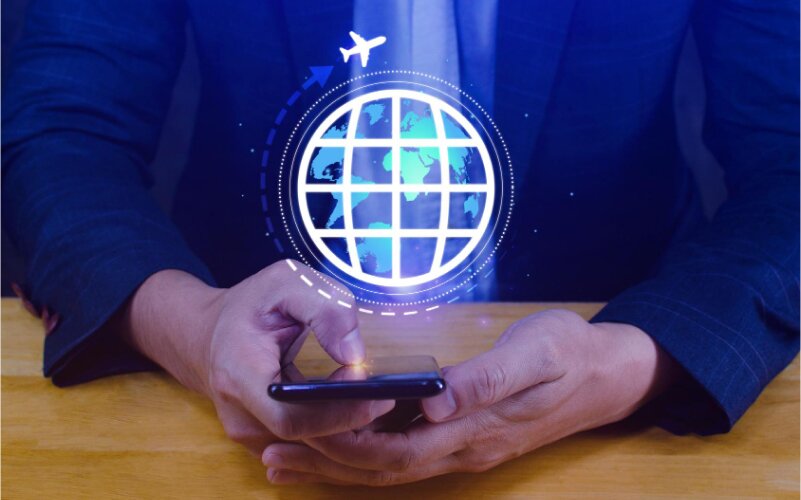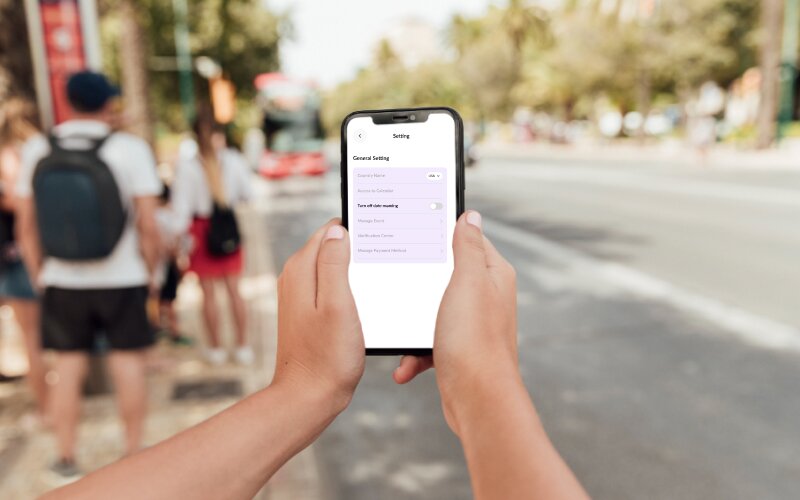
Time and again, a question that bothers travelers and telecom operators, is – how to avoid roaming charges? International roaming services have provided seamless connectivity and the convenience of staying connected for travelers worldwide. But it certainly comes at a cost, which is in the form of high roaming charges that travelers need to pay. Moreover, operators also have to pay prices in the form of significant investment and lower revenue, ultimately leading them to loss. However, this problem can be addressed using virtual roaming solutions that have brought a win-win situation for travelers and operators.
Through this blog post, I want you to learn about the latest and most effective ways to avoid roaming charges including virtual roaming solutions. We will particularly focus on problem areas travelers and operators face with international roaming and the associated solutions. Let’s begin!
What is Roaming?

Roaming is a mobile service that enables travelers to stay connected when they travel outside the coverage area of their primary mobile operator. By using roaming, travelers can continue to make and receive calls, send texts, and use data services as they would use in their home location. Roaming is mainly of two types:
- Domestic Roaming
As the term suggests, domestic roaming is when a mobile phone user connects to another network within the home country region while traveling.
- International Roaming
It is when a mobile phone user connects to a foreign network or a network in a different country while they travel abroad.
What are Roaming Charges?

Roaming charges are the fees that the home network service provider pays to its partner network service provider for the services used. These charges are passed on to the mobile user as roaming charges.
The next obvious question that arises is: which services attract roaming charges? Primarily, there are 4 mobile services that when used on roaming or a different network cause charges:
- Voice Services i.e. making and receiving calls.
- SMS Services i.e. sending and receiving SMS texts.
- Data Services i.e. accessing the internet, using apps, or streaming content.
- Voicemail Services i.e. listening to voicemail messages.
Why are Roaming Charges So High?

Travelers and operators around the world have a common pain area when it comes to roaming: why are roaming charges so expensive? This is because the cost of roaming charges is determined by various factors, which are:
-
Inter-Operator Agreements (IOAs) and Fees
Bilateral agreements between your home network provider and the foreign network provider (the one whose network you are using) are the primary reason for the high cost of roaming charges. While these agreements are often complex, they also involve significant fees.
Suppose you live in the US and travel to Europe. Now as you roam, your home network service provider in the US will rely on the foreign network provider in the EU to provide mobile services such as data and call connectivity. If your home network pays $10 per gigabyte to the carrier in EU, then it might charge $25 per gigabyte to the consumer i.e. you.
It is important to note that home network provider doesn’t control the rates of the new network you’re connecting to. So no matter how high the charges are, your home network provider has to accept them.
-
Lack of Regulation in Many Regions
In June 2017, the EU or the European Union implemented the RLAH or Roam Like At Home regulation, eliminating high cost roaming charges for travelers. However, many parts of the world are still not governed by such regulations to control roaming charges which allows operators to charge hefty amount from international travelers using roaming services.
-
Infrastructure and Technology Costs
Do you know why seamless international connectivity is so complex? It is because of the involvement of different mobile network technologies such as GSM, CDMA, LTE, 5G, etc., with varying frequencies and standards. To ensure that travelers enjoy seamless connectivity as they roam around the world, operators need to make significant technological and operational investments including real-time connectivity, network infrastructures, interoperability and accurate billing systems.
-
Exchange Rate Fluctuations
The calculation for roaming charges is often done in foreign currency. This means that any fluctuations in exchange rates will directly impact the roaming costs passed on to the users or consumers.
-
Limited Competition
Unlike other markets, international roaming has a very few operators that dominate the market. This reduces competition and consumers are left with very limited choices and have to pay the premium charges as set by these operators. For example, many remote regions around the world such as Africa have limited mobile operators leading to extremely high roaming costs.
-
High Data Usage by Travelers
International travelers often rely on data services as they roam using navigation, translation, and communication apps. This heavy usage of data services adds exorbitantly to the roaming bills because data services are being priced premium. For example, using Google Maps while connected to a network other than your home country can add significantly to roaming charges.
-
Additional Fees and Overhead Costs
Many countries impose additional taxes or regulatory fees on roaming services. This in turn makes operators include markups to cover administrative costs to generate profit.
-
Little Flexibility
International roaming plans are often available as bundled. This means that you cannot customize them by choosing the specific features you need. For instance, as you roam overseas, you only need a data plan to access the internet during your trip. However, you will be charged for an entire package that includes calls, texts, and other services, even if you didn’t use them.
In other words, due to less flexibility in roaming plans, consumers need to pay for an entire plan even if they do not use all the features of the plan.
How to Avoid Roaming Charges When Traveling: 11 Effective Ways
In the above section, we just learned about the various reasons that make roaming charges so exorbitant. However, roaming isn’t necessarily always high if you roam the smart way. We have gathered a list of some practical and effective hacks to help you avoid roaming charges when traveling abroad.
Sounds interesting, right? Let’s uncover these hacks:
-
Enable Airplane Mode and Use Wi-Fi

We all are already familiar with using airplane mode on our mobile phones. So when you travel overseas, you can utilize the airplane mode and connect to free WiFi networks to access internet services. This could be done by connecting to public WiFi networks in nearby cafes, restaurants, libraries, etc. It is important to keep in mind that connecting to open or public WiFi networks makes your mobile devices susceptible to cyber threats.
-
Purchase a Local SIM Card

Getting a local SIM card for your visiting land would help you use mobile phone services at local rates. This is especially beneficial for travelers with extended stays or those who require heavy data usage.
-
Leverage Virtual Roaming Solutions
One of the most effective ways to prevent high roaming costs is using virtual roaming apps, which are offered by mobile network operators. These innovative apps help users avoid the traditional roaming costs and still keep them connected when they are in a foreign land.

Operators have this great opportunity to expand their services and reclaim the lost roaming revenue by leveraging virtual roaming apps. They don’t need to put a lot of effort into maintaining infrastructure and contracts with foreign networks. This means that they can easily offer affordable roaming services to their subscribers while still earning their profits.
REVE virtual roaming app is one such solution that operators can leverage to broaden their service portfolio. Our app-based virtual roaming solution enables operators to offer significant savings and convenience for subscribers. It’s a solution that benefits both operators and subscribers.
-
Use International Roaming Packs
Another effective way to trim roaming charges is by subscribing to international roaming packages. These packages often bundle voice, text, and data services at discounted prices. Check with your home country carrier for the available roaming packs and choose the ones that best fit your requirements.
-
Rely on Internet-Based Communication Apps
These days there are dozens of internet-based apps like WhatsApp, Skype, Zoom, etc., which international travelers can use to connect via calls and texts. Since these apps easily work over WiFi networks, travelers can save on roaming charges.
-
Turn Off Data Roaming

Often mobile devices come with data roaming options turned on by default. When you are traveling to a foreign destination, try to disable the data roaming option in your phone settings. Otherwise, your phone will automatically connect to the visiting country’s network, causing roaming charges.
-
Download Offline Maps and Content
Another secret hack to avoid paying heavy roaming bills is downloading the essential content before you leave for your trip. This includes maps, music, and videos so that your navigation and entertainment needs are fulfilled without incurring roaming fees.
-
Invest in a Portable WiFi Device
A portable WiFi device can be your companion to stay connected during your international trip. Such a device allows you to connect multiple mobile devices to the internet at a fixed daily or weekly charge. This is extremely useful for people traveling in groups.
-
Opt for an International SIM Card

Getting an international SIM card is also a wise investment for those who frequently travel around the world. Such a SIM offers competitive roaming charges across multiple countries, helping you save more.
-
Check Carrier Policy and Usage
Keeping an eye on your data usage can help you manage your roaming costs quite effectively. Before you leave for your international trip, check your carrier’s international roaming policies to learn how much you will be charged for your usage. Also, set up usage alerts on your mobile device to monitor your usage and avoid unexpected bills.
-
Disable Background Data Consumption
Often travelers forget the fact that many apps run in the background and consume data. These apps such as social media apps can add to their roaming charges which is why it is important to disable them before you land at your destination.
How to Avoid Roaming Charges: Key Takeaway!
Amongst all the hacks that we discussed to avoid international roaming, we find virtual roaming apps to be the most effective ones. Virtual roaming solutions eliminate the dependence of operators on costly inter-operator agreements. They enable operators to offer competitive international communication services to retain their customers. There’s no need of operators to invest significantly in infrastructure and still expand their services, which is amazing. Last but not the least, operators can innovate on pricing models to attract more consumers and grow their business.
According to Juniper Research, the total number of roaming connections will increase by 350% by 2028. With the roaming connectivity landscape changing rapidly, are you going to let go of this opportunity to grow your business and generate more profits? Connect with us for a free demo!
Frequently Asked Questions
Can I use my phone overseas without roaming?
Yes, there are various ways with which you can use your mobile phone overseas without roaming enabled. Some of the most effective ways include virtual roaming apps, local SIM cards, or using WiFi connections.
What are roaming charges?
Roaming charges are the fees that mobile network operators charge to their subscribers when they use their mobile phones on a foreign network i.e. when traveling internationally. These charges are applied to various services such as voice calls, text messages and data usage.
How does a virtual roaming solution differ from traditional roaming?
A traditional roaming setup relies on agreements between mobile operators to ensure seamless connectivity through foreign networks. Here, both operators and consumers pay high roaming charges. On the other hand, virtual roaming solutions make use of cloud-based technology to route calls, and data over the internet. This eliminates the need for agreements between operators, making roaming an affordable affair for both operators and consumers.
Do I need a new SIM card to use a virtual roaming app?
No, a mobile user can use a virtual roaming app with their existing SIM card. These apps utilize internet connectivity to provide communication and data services to travelers. So there’s no hassle of purchasing a new SIM card.
Which businesses can benefit from virtual roaming solutions?
MNOs i.e. Mobile Network Operators, MVNOs i.e. Mobile Virtual network Operators and Landline Operators are amongst the top businesses that can benefit from virtual roaming solutions.
Do virtual roaming solutions support multiple devices?
Yes, virtual roaming solutions can be used on various devices including smartphones, tablets, laptops, etc.




























